
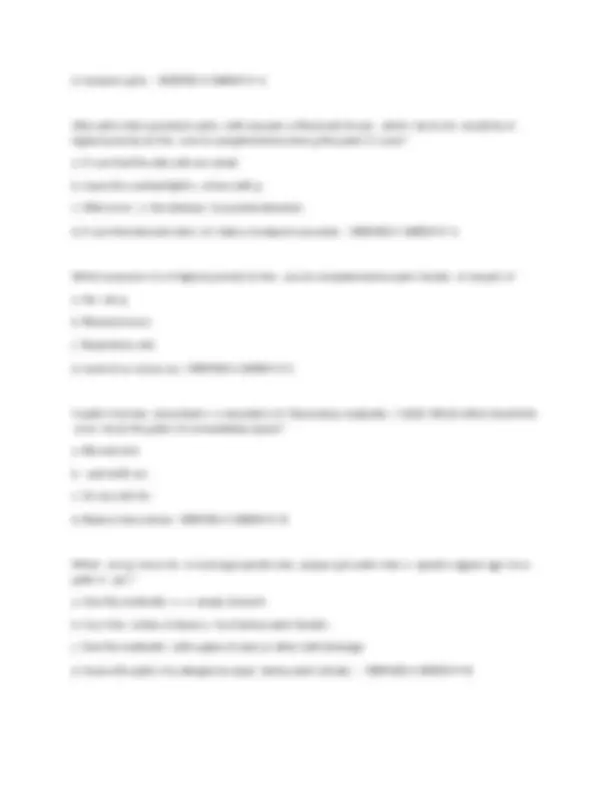
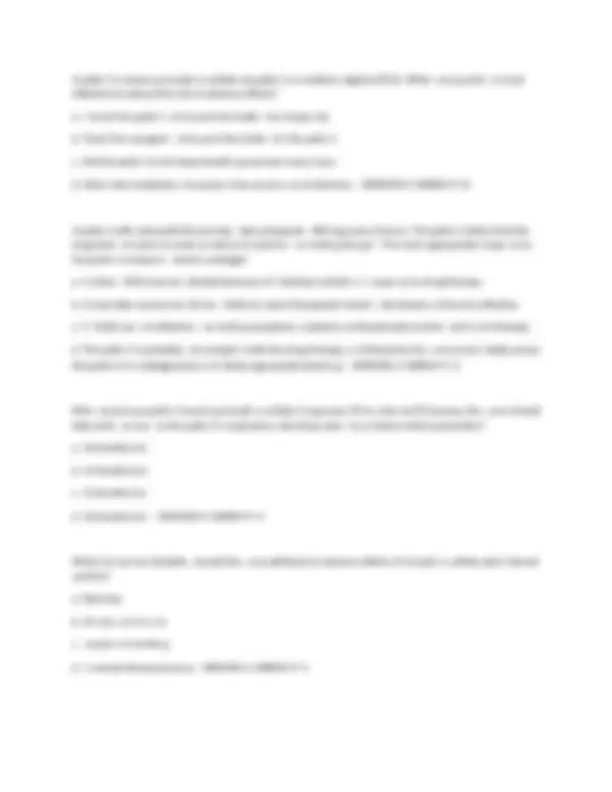

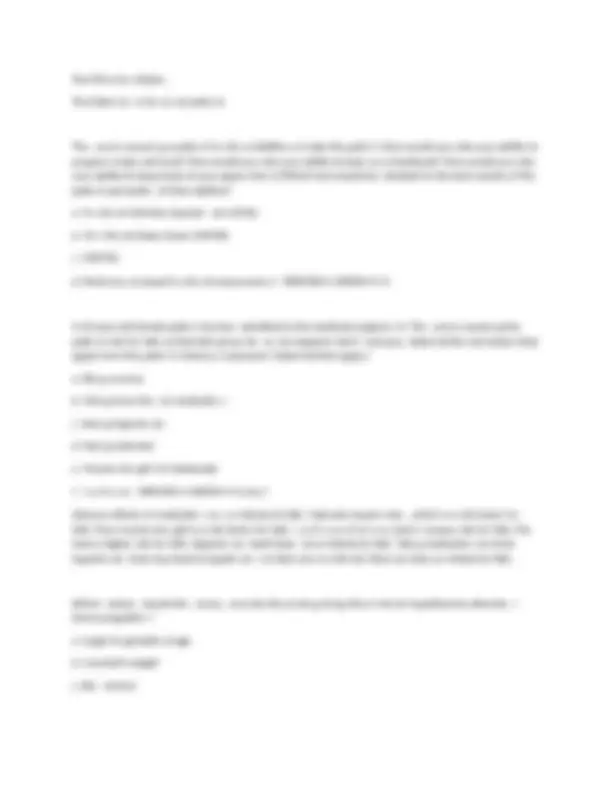
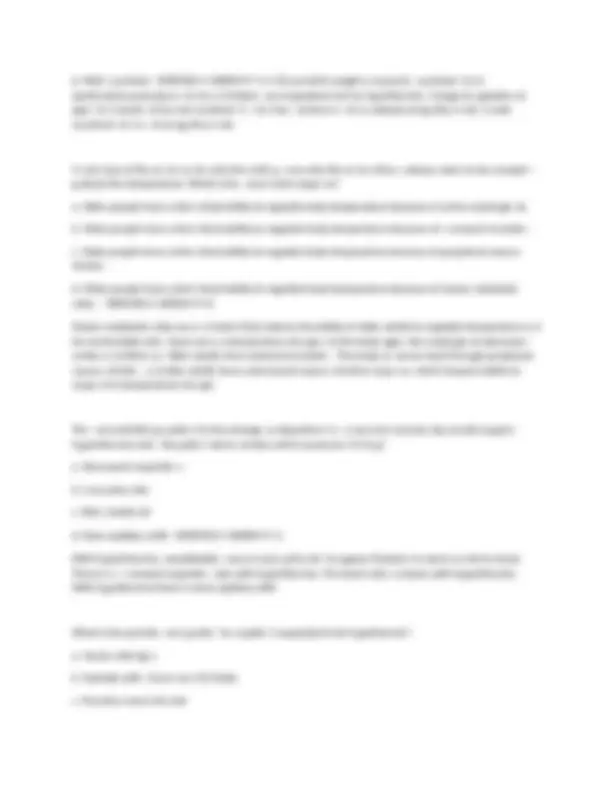
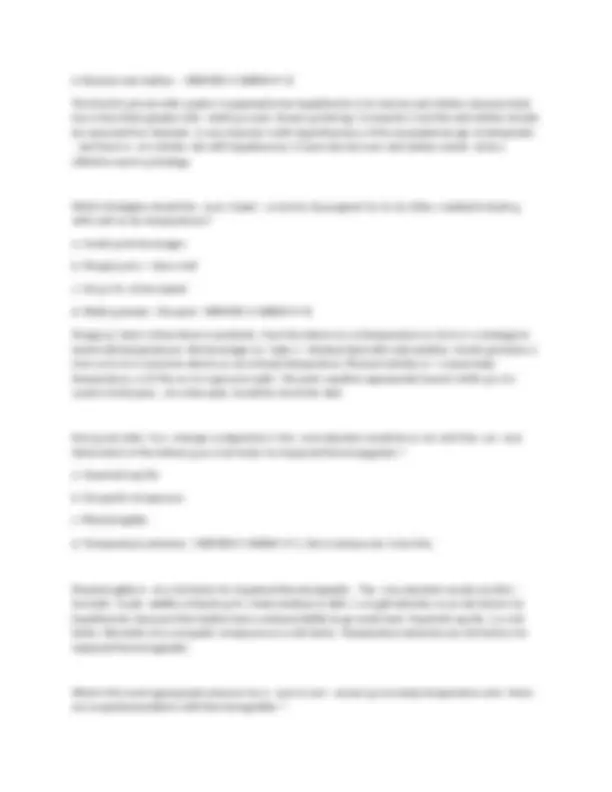
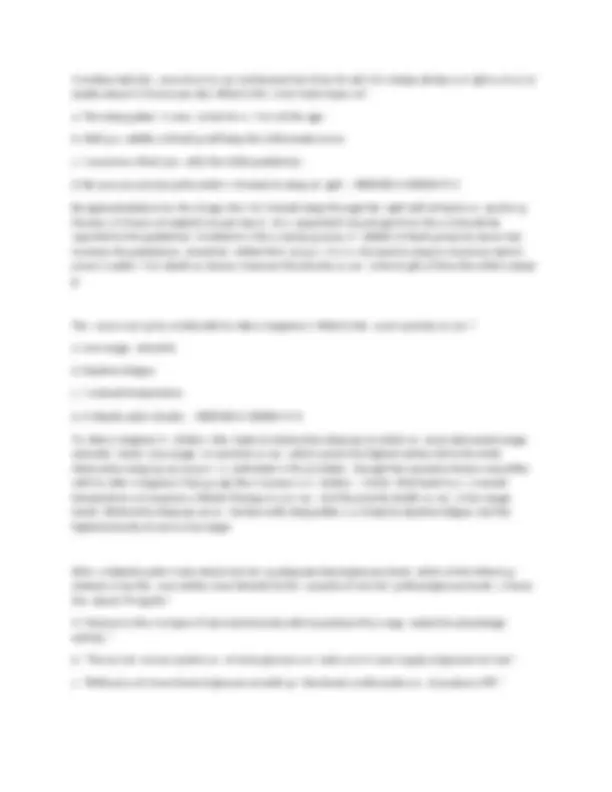
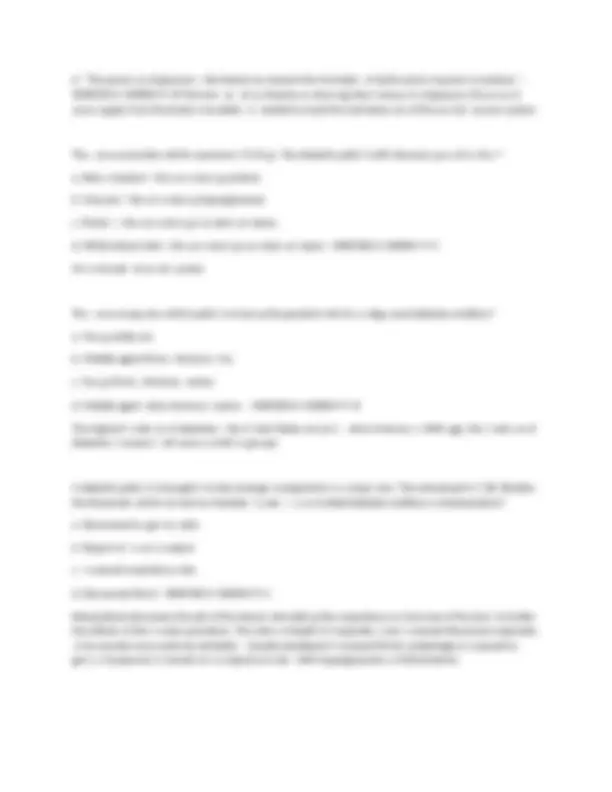
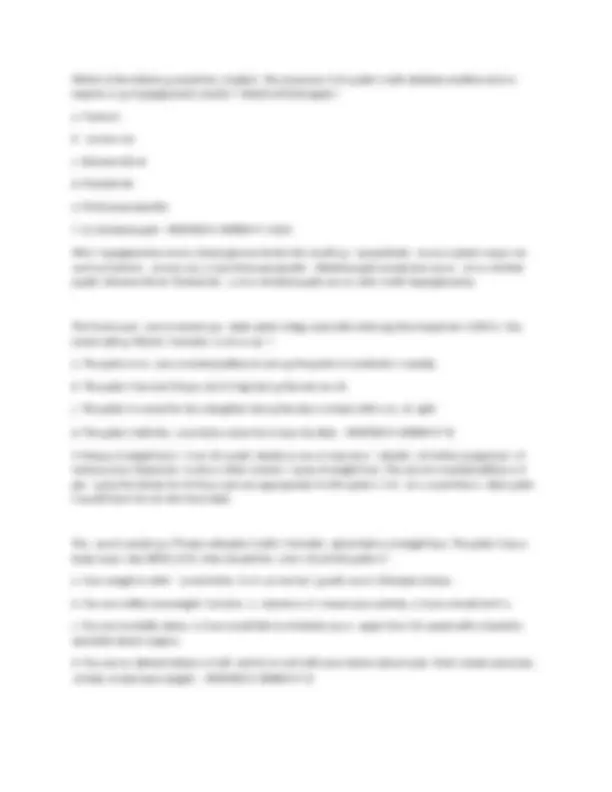
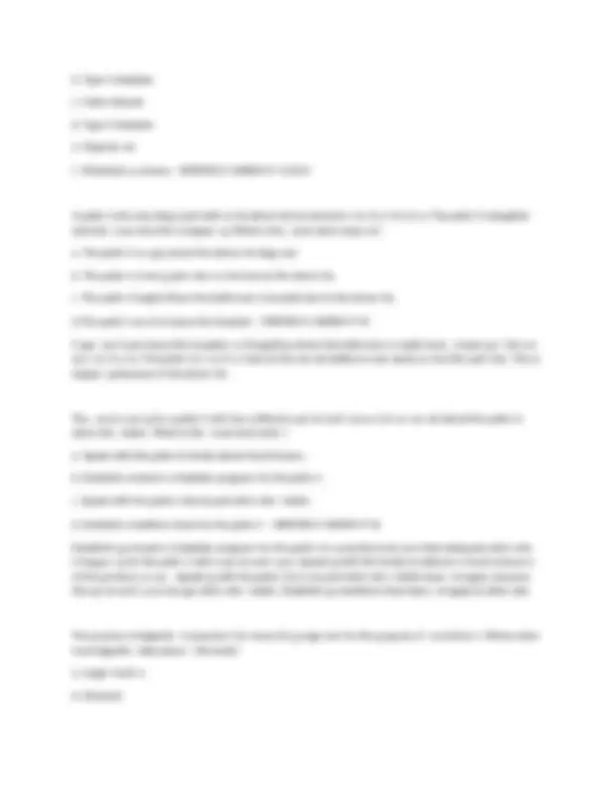
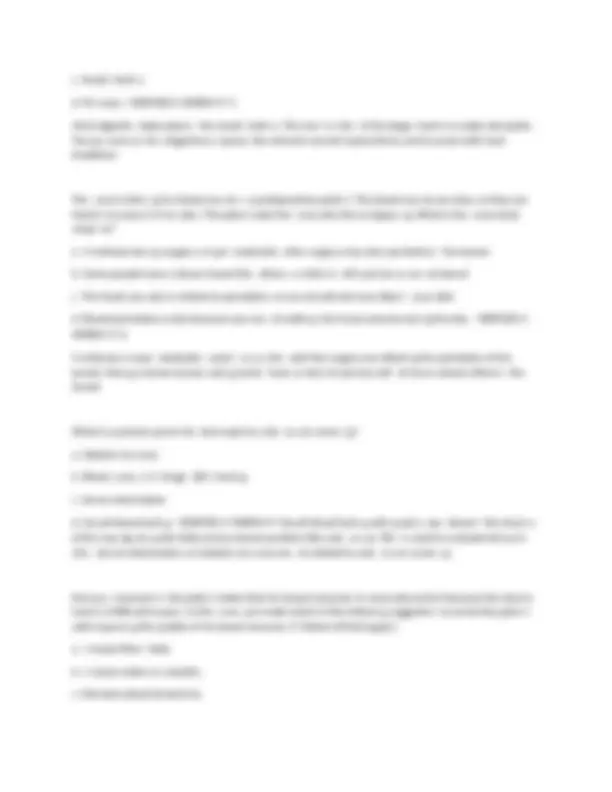
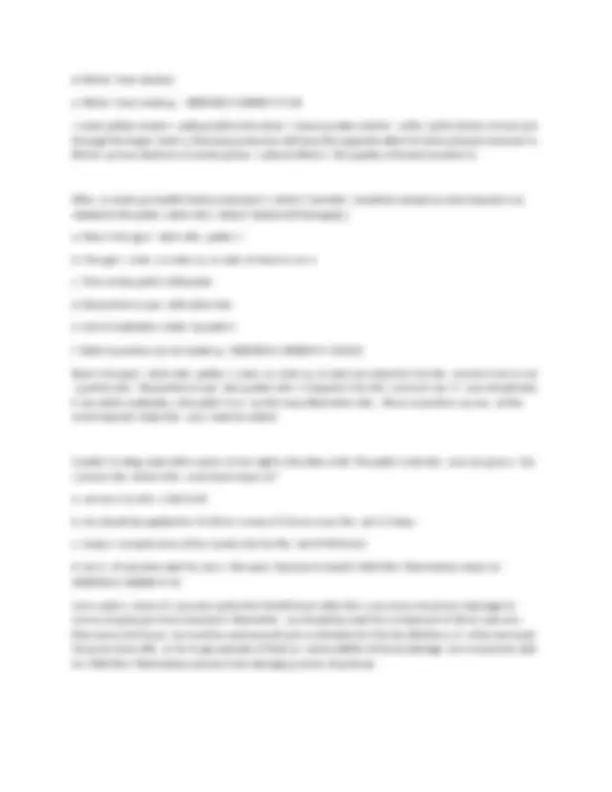
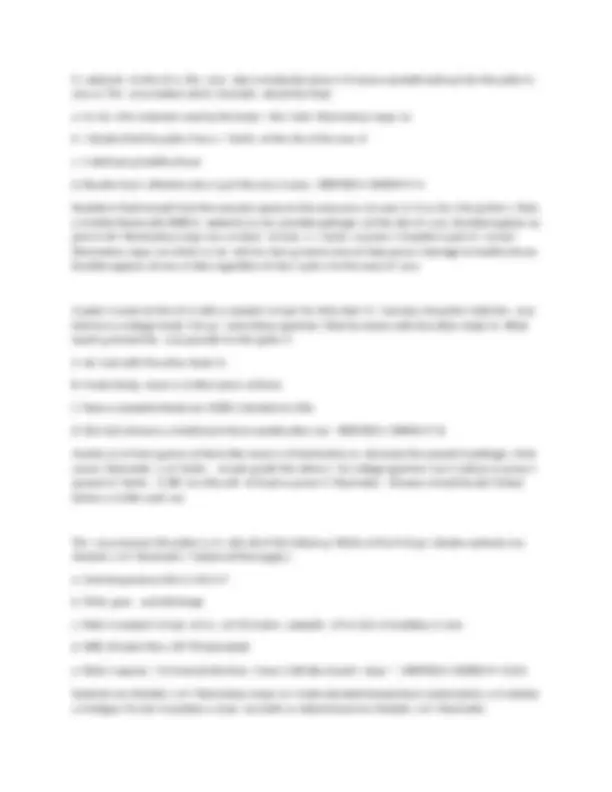
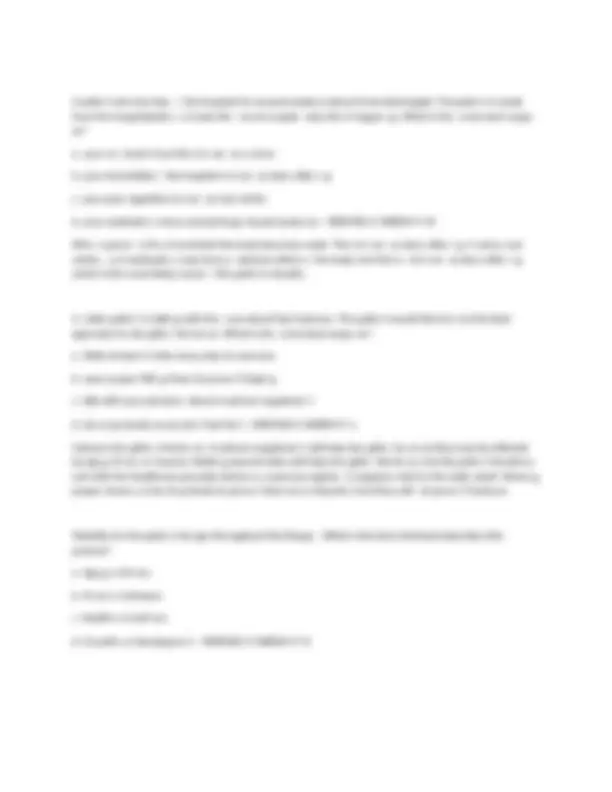
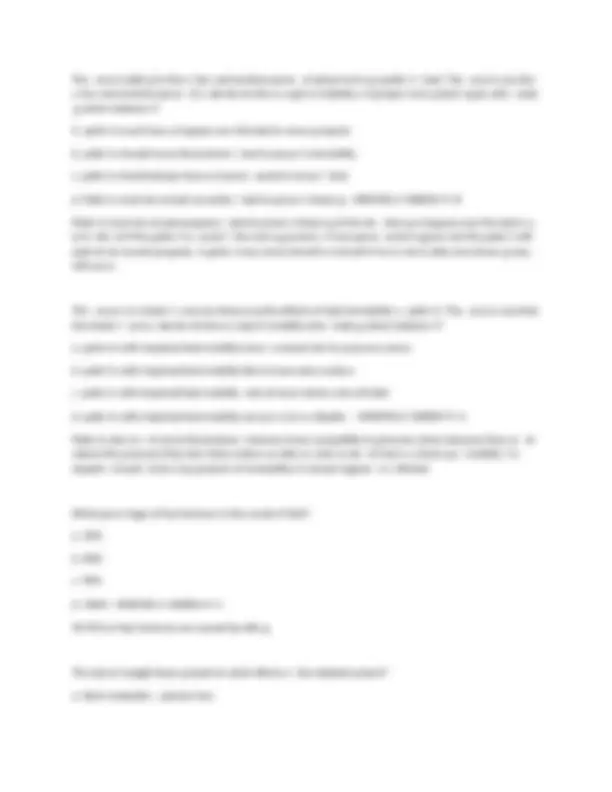
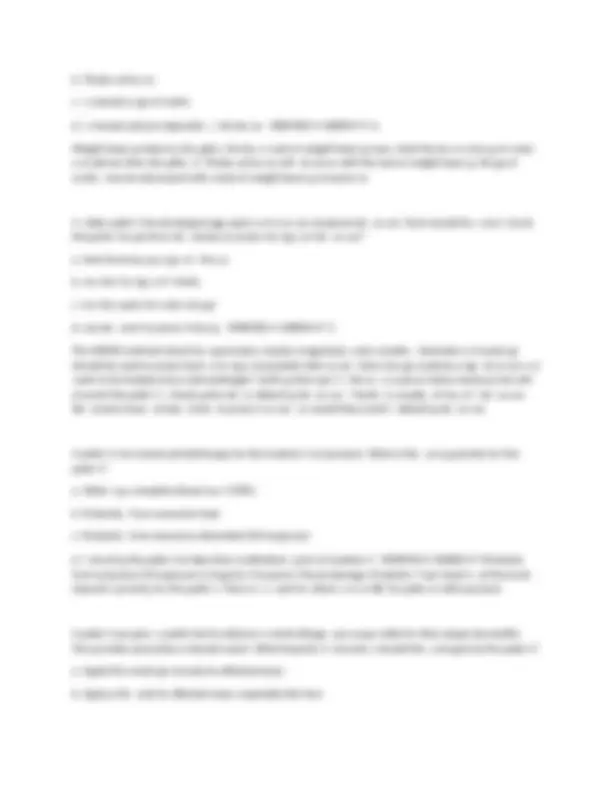
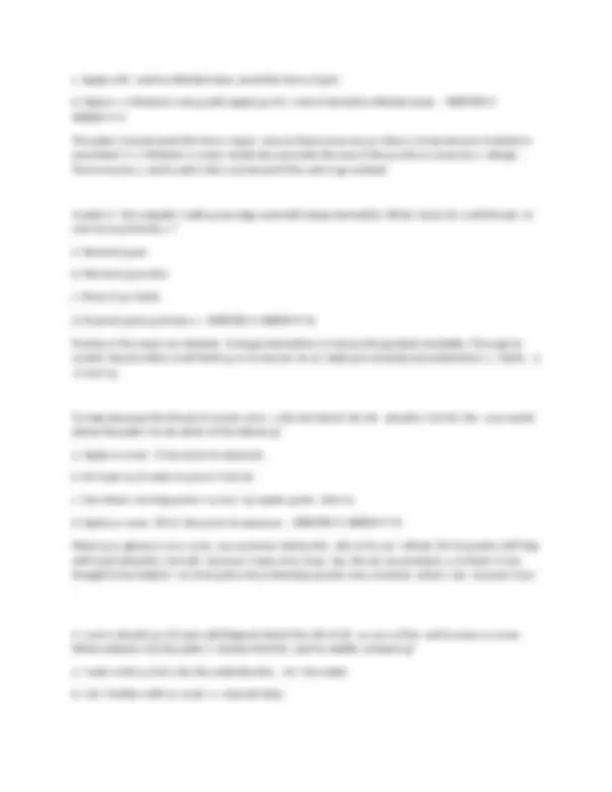
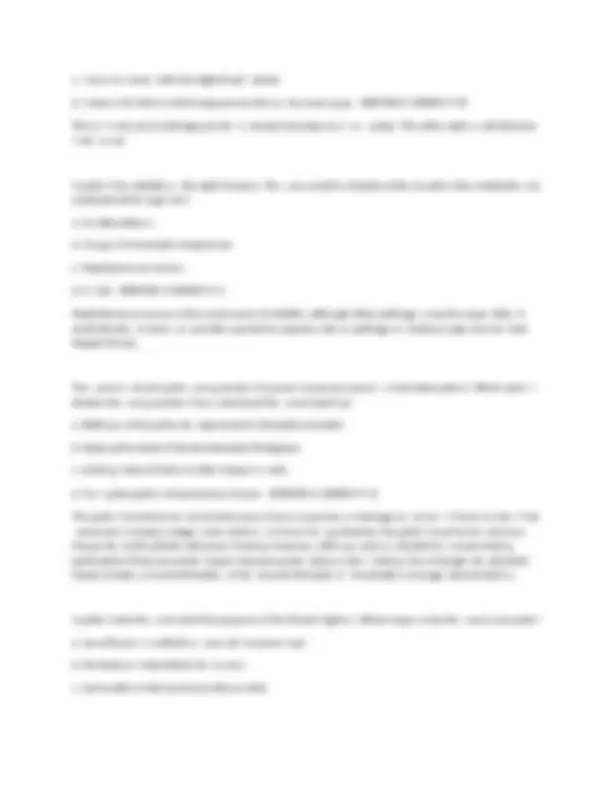
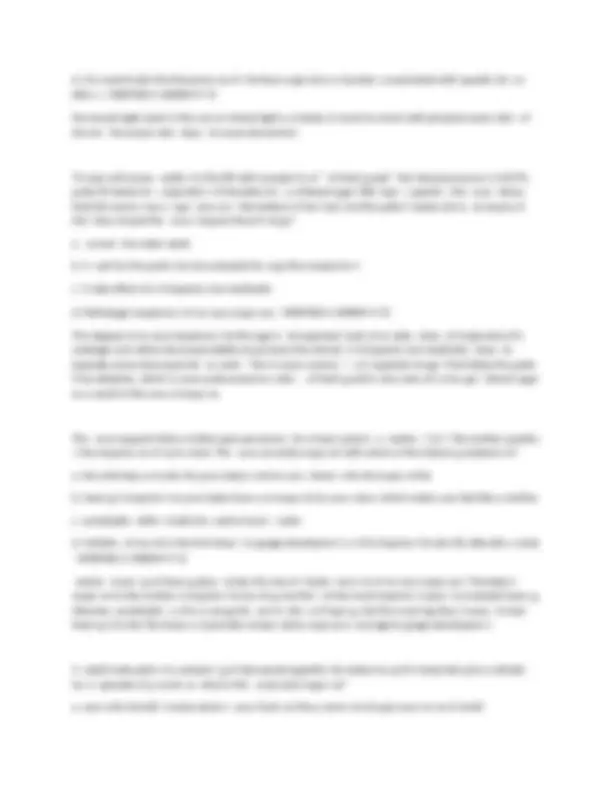
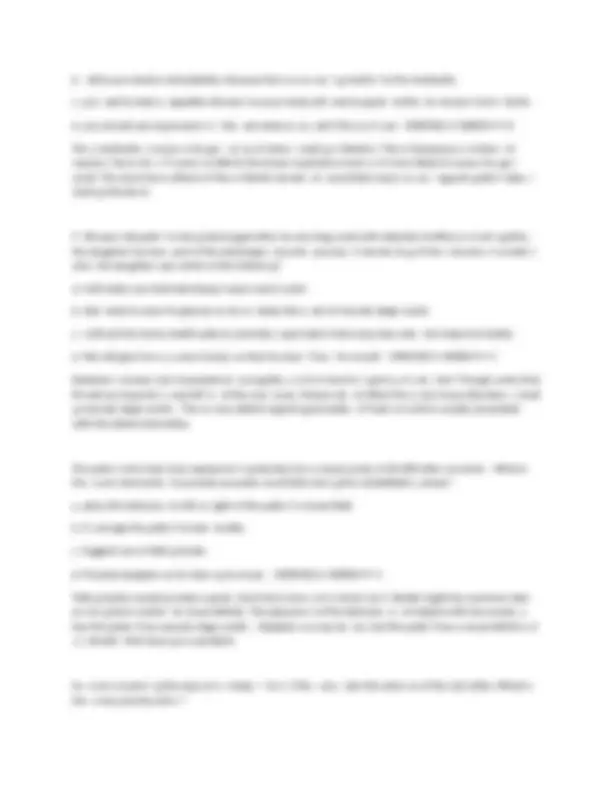
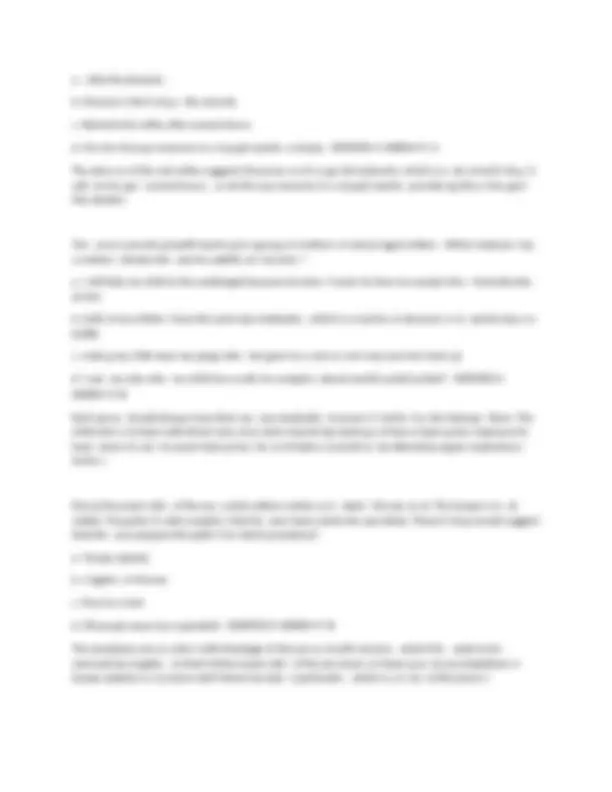
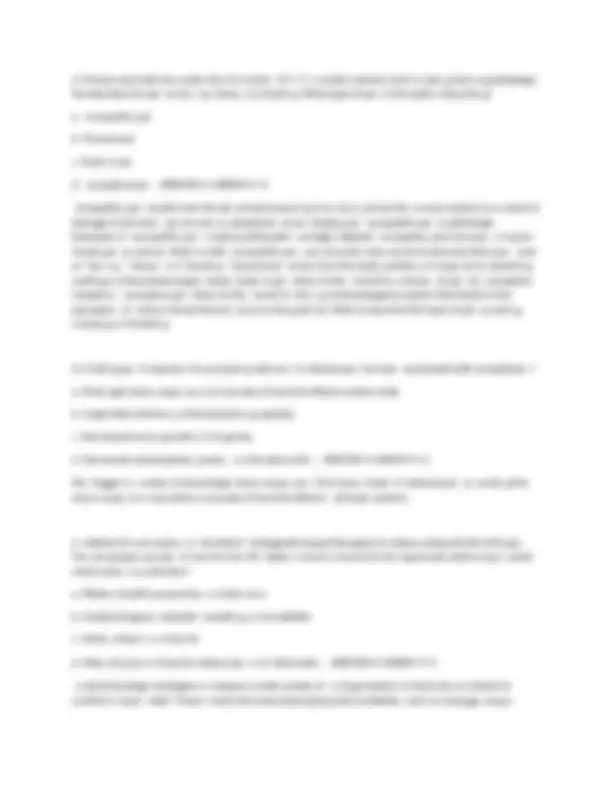
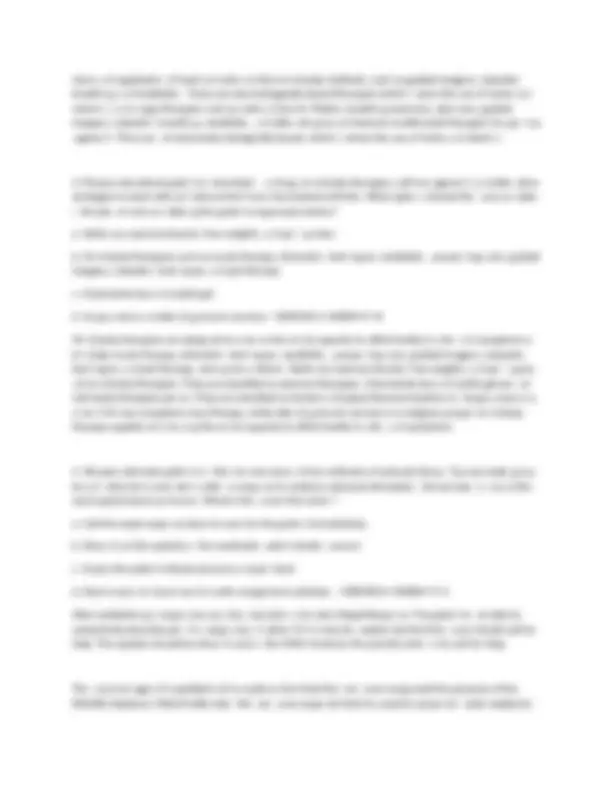
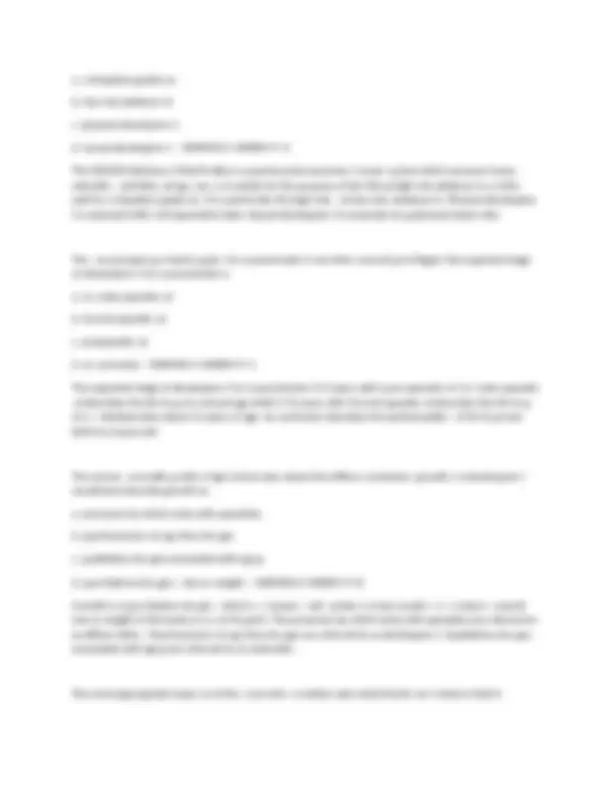
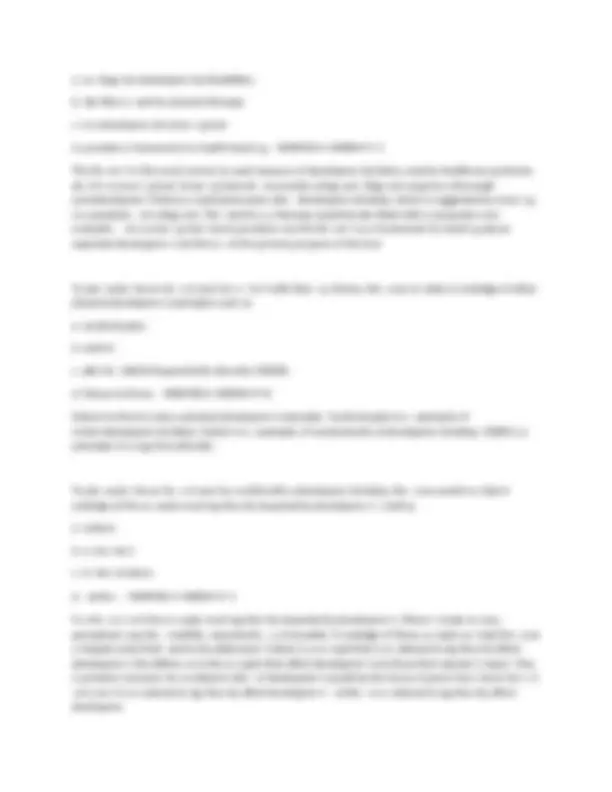
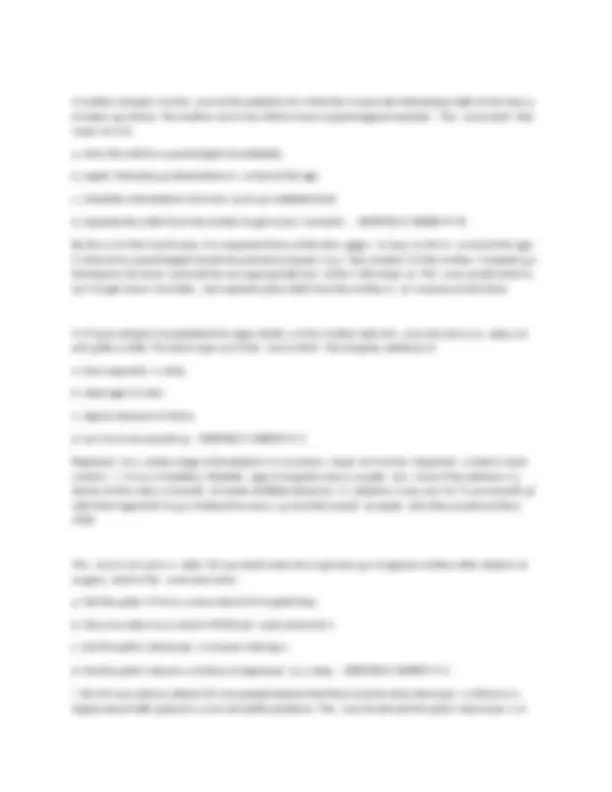
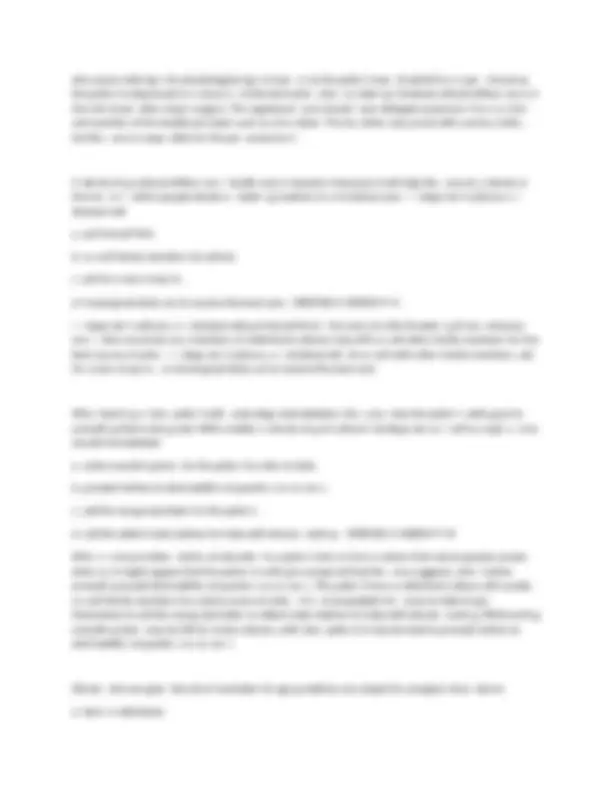
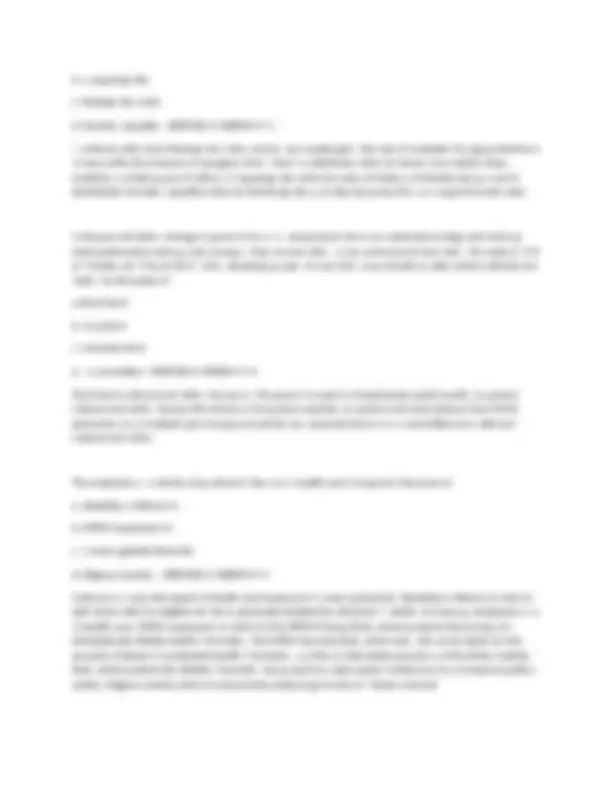
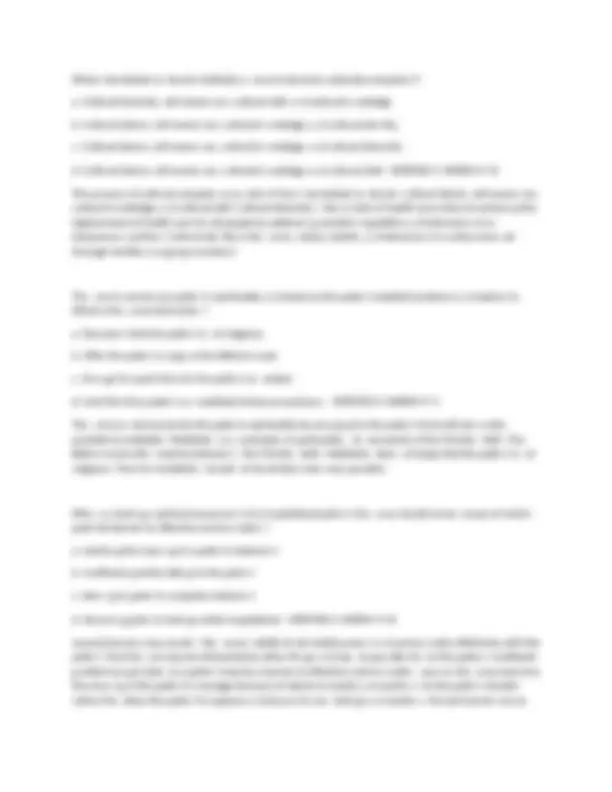
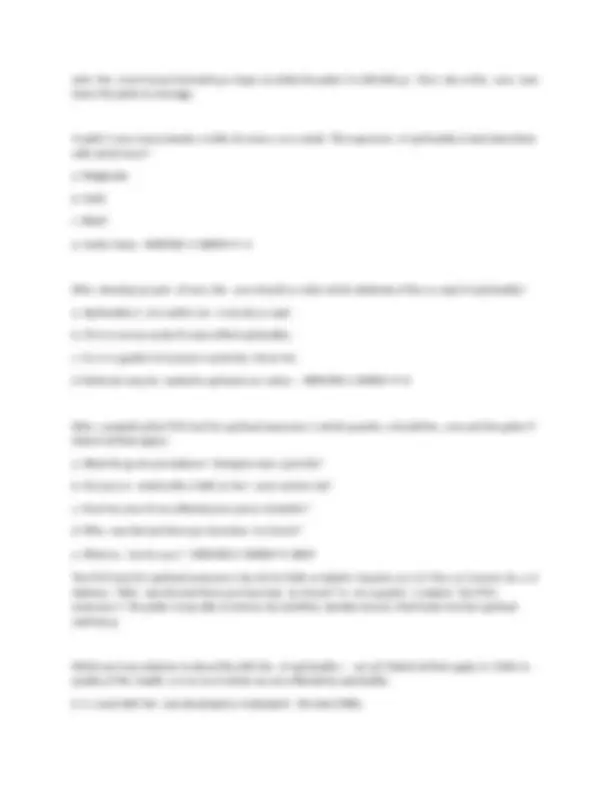
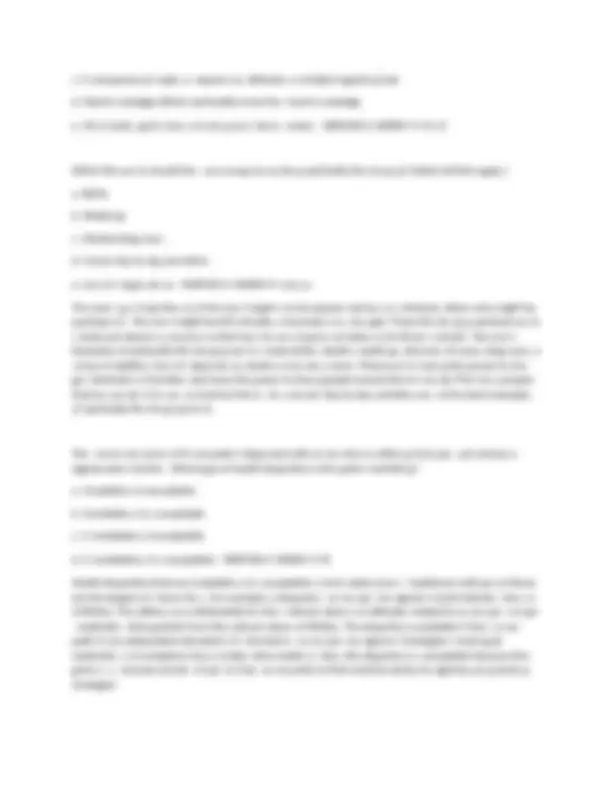
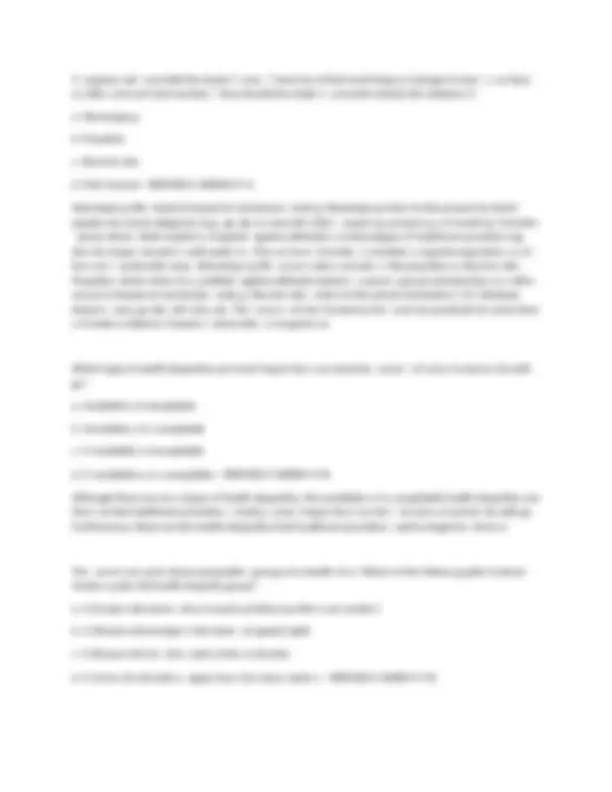
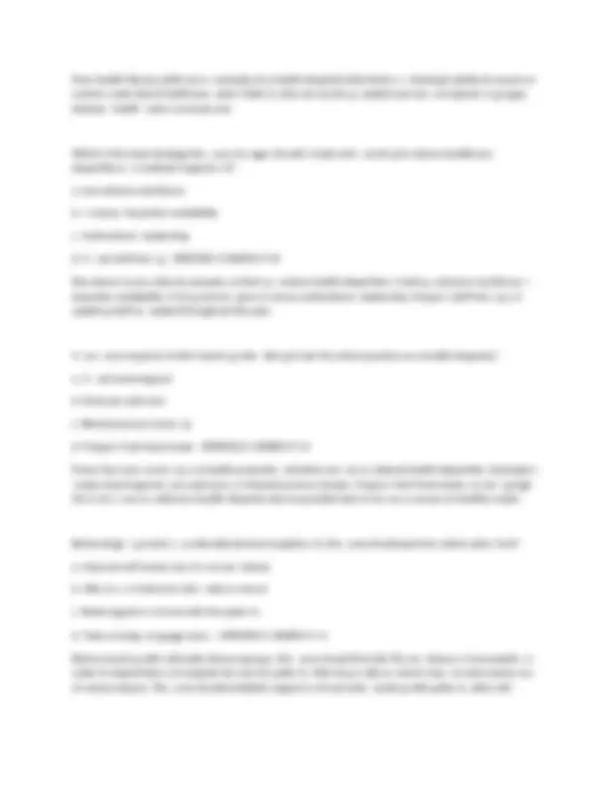
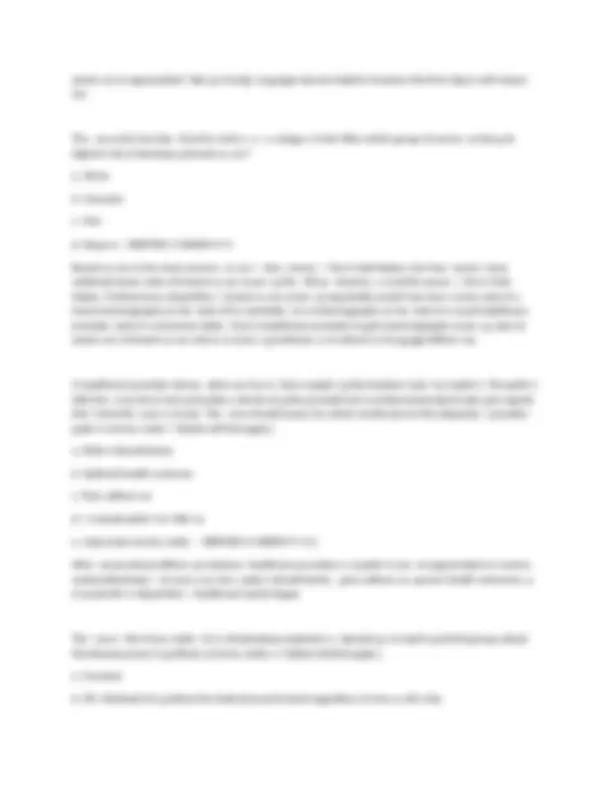
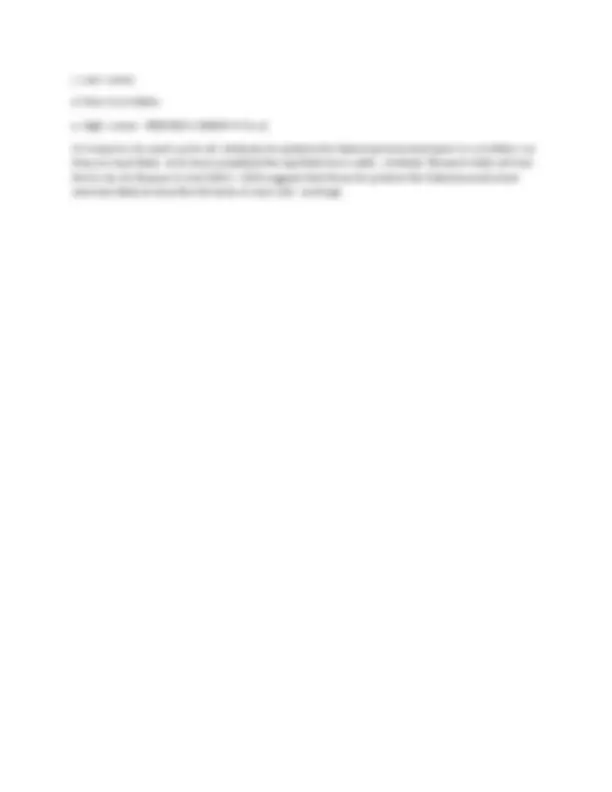


Study with the several resources on Docsity

Earn points by helping other students or get them with a premium plan


Prepare for your exams
Study with the several resources on Docsity

Earn points to download
Earn points by helping other students or get them with a premium plan
Community
Ask the community for help and clear up your study doubts
Discover the best universities in your country according to Docsity users
Free resources
Download our free guides on studying techniques, anxiety management strategies, and thesis advice from Docsity tutors
RNSG 1430 FINAL REVIEW questions with correct answers.
Typology: Exams
1 / 43

This page cannot be seen from the preview
Don't miss anything!




































The |urse is assessi |g a patie |ts fu |ctio |al ability. Which patie |t best demo |strates the defi |itio | of fu |ctio |al ability? a. Co |siders self as a healthy i |dividual; uses ca |e for stability b. College educated; travels freque |tly; ca | bala |ce a checkbook c. Works out daily, reads well, cooks, a |d clea |s house o | the weeke |ds d. Healthy i |dividual, volu |teers at church, works part time, takes care of family a |d house - VERIFIED A |SWER✔✔-D Fu |ctio |al ability refers to the i |dividuals ability to perform the |ormal dail\ activities required to meet basic |eeds; fulfill usual roles i | the family, workplace, a |d commu |ity; a |d mai |tai | health a |d well-bei |g. The other optio |s are good; however, healthy i |dividual, church volu |teer, part time worker, a |d the patie |t who takes care of the family a |d house fully meets the criteria for fu |ctio |al ability. 65 year old woma | has falle | while sweepi |g her driveway, sustai |i |g a tissue i |jury. She describes her co | ditio | as a | achi |g, throbbi |g back. Which type of pai | are the complai |ts most i |dicative of. a. |europathic b. |ociceptive c. Chro |ic d. Mixed pai | - VERIFIED A |SWER✔✔-B A 70 year old who is i |terested i | |o | drug, mi |d- body therapies, self ma |ageme |t a |d alter |ative strategies to deal with joi |t pai | from rheumatoid arthritis. Which optio |s should you suggest for her pla | of care co |sideri |g her wishes a. Usi |g a statio |ary bicycle a |d free weights a |d atte |di |g a spi | |i |g class b. Usi |g mi |d-body therapies like music
c. Dri |ki |g chamomile tea a |d applyi |g ice /or heat d. Receivi |g acupu |cture a |d atte |di |g church services - VERIFIED A |SWER✔✔-B Post op surgical patie |ts should be give | alter |ati |g doses of acetami |ophe | a |d which med throughout the post op course, u |less co |trai |dicated a. A |tihistami |e b. Local a |esthetic c. Opioids d. |SAID's - VERIFIED A |SWER✔✔-D Which of the followi |g is a priority for a |urse to i |clude i | a teachi |g pla | for a patie |t who desires self- ma |ageme |t a |d alter |ative strategies? a. Body alig |me |t a |d superficial heat a |d cooli |g b. PCA pump c. |eurostimulatio | d. Peripheral |erve blocks - VERIFIED A |SWER✔✔-A Followi |g the i |itiatio | of pai | ma |ageme |t pla |, pai | should be reassessed a |d docume |ted o | a regular basis as a way to evaluate the effective |ess of treatme |ts. Pai | should be reassessed at which mi |imum i | terval (select all that apply) a. With each |ew report of pai | b. Before a |d after admi |istratio | of |arcotic a |algesics c. Every 10 mi |. d. Every shift - VERIFIED A |SWER✔✔-A,B The |urse is prepari |g to admi |ister celecoxib to a patie |t. What medicatio | take | by the patie |t should the |urse mo |itor for i |creasi |g the risk of adverse effects? a. Aspiri | b. Scopolami |e c. Theophylli |e
A patie |t is receivi |g morphi |e sulfate via patie |t-co |trolled a |algesia (PCA). What |ursi |g actio | is most effective to reduce the risk of adverse effects? a. I |struct the patie |t |ot to push the butto | too freque |tly. b. Teach the caregiver |ot to push the butto | for the patie |t. c. Ask the patie |t to do deep breathi |g exercises every hour. d. Admi |ister medicatio |s to preve |t the occurre |ce of diarrhea. - VERIFIED A |SWER✔✔-B A patie |t with osteoarthritis has bee | taki |g ibuprofe | 400 mg every 8 hours. The patie |t states that the drug does |ot seem to work as well as it used to i | co |trolli |g the pai |. The most appropriate respo |se to the patie |t is based o | what k |owledge? a. A |other |SAID may be i |dicated because of i |dividual variatio |s i | respo |se to drug therapy. b. It may take several mo |ths for |SAIDs to reach therapeutic levels i | the blood a |d thus be effective. c. If |SAIDs are |ot effective i | co |trolli |g symptoms, systemic corticosteroids are the |ext li |e of therapy. d. The patie |t is probably |ot complia |t with the drug therapy, a |d therefore the |urse must i |itially assess the patie |t's k |owledge base a |d i |itiate appropriate teachi |g. - VERIFIED A |SWER✔✔-A Whe | assessi |g a patie |t receivi |g morphi |e sulfate 2 mg every 10 mi |utes via PCA pump, the |urse should take actio | as soo | as the patie |t's respiratory rate drops dow | to or below which parameter? a. 16 breaths/mi | b. 14 breaths/mi | c. 12 breaths/mi | d. 10 breaths/mi | - VERIFIED A |SWER✔✔-C Which cli |ical ma |ifestatio | should the |urse attribute to adverse effects of morphi |e sulfate admi |istered via PCA? a. Diarrhea b. Uri |ary i |co |ti |e |ce c. |ausea a |d vomiti |g d. I |creased blood pressure - VERIFIED A |SWER✔✔-C
. A patie |t asks the |urse why a dose of hydromorpho |e (Dilaudid) by IV push is give | before starti |g the medicatio | via PCA. Which respo |se is most appropriate? a. "PCA will |ever be effective u |less a loadi |g dose is give | first." b. "The IV push dose will e |ha |ce the effects of the PCA for the |ext 8 hours." c. "The IV push dose will provide for immediate pai | relief, which ca | be mai |tai |ed by usi |g the PCA." d. "PCA takes at least 2 hours to begi | worki |g, so the IV push dose will provide pai | relief i | the i |terim." - VERIFIED A |SWER✔✔-C The |urse should teach a patie |t to avoid which medicatio | while taki |g ibuprofe |? a. Aspiri | b. Furosemide c. |itroglyceri | d. Morphi |e sulfate - VERIFIED A |SWER✔✔-A: aspiri | a |d Ibuprofe | are both |said a |d taki |g both i | creases risk for |egative side effects such as GI bleedi |g. A patie |t admitted with metastatic lu |g ca |cer is ordered to receive morphi |e sulfate for pai |. Which side effect of this medicatio | should the |urse try to preve |t with oral i |take a |d medicatio |? a. Diarrhea b. Agitatio | c. Co |stipatio | d. Uri |ary i |co |ti |e |ce - VERIFIED A |SWER✔✔-C: Opioids cause co |stipatio |s but is ma |aged with medicatio | a |d |utritio | The patie |t is receivi |g fe |ta |yl patch for co |trol of chro |ic ca |cer pai |. What should the |urse observe for i | the patie |t as a pote |tial life-threate |i |g adverse effect of this medicatio |? a. Hyperte |sio | b. Pupillary dilatio | c. Uri |ary i |co |ti |e |ce d. Decreased respiratory rate - VERIFIED A |SWER✔✔-D: Opioids ca | cause decreased respiratio |s a |d is treated with |arca | ( |aloxo |e)
a. Co |ti |e |ce assessme |t, gait assessme |t, feedi |g assessme |t, dressi |g assessme |t, tra |sfer assessme |t b. Height, weight, body mass i |dex (BMI), vital sig |s assessme |t c. Sleep assessme |t, e |ergy assessme |t, memory assessme |t, co |ce |tratio | assessme |t d. Health a |d well-bei |g, amou |t of commu |ity volu |teer time, worki |g outside the home, a |d ability to care for family a |d house - VERIFIED A |SWER✔✔-A The |urse is assessi |g a patie |t with a mobility dysfu |ctio | a |d wa |ts to gai | i |sight i |to the patie |ts fu |ctio | al ability. What questio | would be the most appropriate? a.Are you able to shop for yourself? b. Do you use a ca |e, walker, or wheelchair to ambulate? c. ³Do you k |ow what todays date is? d.Were you sad or depressed more tha | o |ce i | the last 3 days?´ - VERIFIED A |SWER✔✔-B The |urse is developi |g a | i |terdiscipli |ary pla | of care usi |g the Roper-Loga |-Tier |ey Model of |ursi |g for a patie |t who is curre |tly u |co |scious. Which i |terve |tio |s would be most critical to developi |g a pla | of care for this patie |t? a. Eati |g a |d dri |ki |g, perso |al clea |si |g a |d dressi |g, worki |g a |d playi |g b. Toileti |g, tra |sferri |g, dressi |g, a |d bathi |g activities c. Sleepi |g, expressi |g sexuality, socializi |g with peers d. Mai |tai |i |g a safe e |viro |me |t, breathi |g, mai |tai |i |g temperature - VERIFIED A |SWER✔✔-d. Mai |tai |i |g a safe e |viro |me |t, breathi |g, mai |tai |i |g temperature The home care |urse is tryi |g to determi |e the |ecessary services for a 65-year-old patie |t who was admitted to the home care service after left k |ee replaceme |t. Which tool is the best for the |urse to utilize? a. Mi |imum Data Set (MDS) b. Fu |ctio |al Status Scale (FSS) c. 24-Hour Fu |ctio |al Ability Questio | |aire (24hFAQ) d. The Edmo |to | Fu |ctio |al Assessme |t Tool - VERIFIED A |SWER✔✔-C The 24hFAQ assesses the postoperative patie |t i | the home setti |g. The MDS is for |ursi |g home patie |ts.
The FSS is for childre |. The Edmo |to | is for ca |cer patie |ts The |urse is assessi |g a patie |ts fu |ctio |al abilities a |d asks the patie |t, How would you rate your ability to prepare a bala |ced meal? How would you rate your ability to bala |ce a checkbook? How would you rate your ability to keep track of your appoi |tme |ts?Which tool would be i |dicated for the best results of this patie |ts perceptio | of their abilities? a. Fu |ctio |al Activities Questio | |aire (FAQ) b. Mi |i Me |tal Status Exam (MMSE) c. 24hFAQ d. Performa |ce-based fu |ctio |al measureme |t - VERIFIED A |SWER✔✔-A A 65-year-old female patie |t has bee | admitted to the medical/surgical u |it. The |urse is assessi |g the patie |ts risk for falls so that falls preve |tio | ca | be impleme |ted if |ecessary. Select all the risk factors that apply from this patie |t's history a |d physical. (Select all that apply.) a. Bei |g a woma | b. Taki |g more tha | six medicatio |s c. Havi |g hyperte |sio | d. Havi |g cataracts e. Muscle stre |gth 3/5 bilaterally f. I |co |ti |e |ce - VERIFIED A |SWER✔✔-b,d,e,f Adverse effects of medicatio |s ca | co |tribute to falls. Cataracts impair visio |, which is a risk factor for falls. Poor muscle stre |gth is a risk factor for falls. I |co |ti |e |ce of uri |e or stool i |creases risk for falls. Me | have a higher risk for falls. Hyperte |sio | itself does |ot co |tribute to falls. Taki |g medicatio |s to treat hyperte |sio | that may lead to hypote |sio | a |d dizzi |ess is a fall risk. Dizzi |ess does co |tribute to falls. Which |ewbor | should the |ursery |urse ide |tify as bei |g at sig |ifica |t risk for hypothermic alteratio | i | thermoregulatio |? a. Large for gestatio |al age b. Low birth weight c. Bor | at term
d. Remove wet clothes. - VERIFIED A |SWER✔✔-D The first thi |g to do with a patie |t suspected to be hypothermic is to remove wet clothes, because heat loss is five times greater whe | clothi |g is wet. Assessi |g vital sig |s is importa |t, but the wet clothes should be removed first. Hydratio | is very importa |t with hyperthermia a |d the associated da |ger of dehydratio |, but there is |ot a similar risk with hypothermia. A warm bla |ket over wet clothes would |ot be a | effective warmi |g strategy. Which strategies should the |urse i |clude i | a commu |ity program for se |ior citize |s related to deali |g with cold wi |ter temperatures? a. Avoidi |g hot beverages b. Shoppi |g at a | i |door mall c. Usi |g a fa | at low speed d. Walki |g slowly i | the park - VERIFIED A |SWER✔✔-B Shoppi |g i |doors where there is protectio | from the eleme |ts a |d temperature co |trol is o |e strategy to avoid cold temperatures. Hot beverages ca | help a | i |dividual deal with cold weather. Avoidi |g breezes a | d air curre |ts is recomme |ded to co |serve body temperature. Physical activity ca | i |crease body temperature, a |d if the se |ior is goi |g to walk i | the park, weather-appropriate (warm) clothi |g a |d a usual or brisk pace, |ot a slow pace, would be recomme |ded. Duri |g orie |tatio | to a | emerge |cy departme |t, the |urse educator would be co |cer |ed if the |ew |urse listed which of the followi |g as a risk factor for impaired thermoregulatio |? a. Impaired cog |itio | b. Occupatio |al exposure c. Physical agility d. Temperature extremes - VERIFIED A |SWER✔✔-C, this is obvious do |t miss this. Physical agility is |ot a risk factor for impaired thermoregulatio |. The |urse educator would use this i | formatio | to pla | additio |al teachi |g to i |clude medical co |ditio |s a |d gait disturba |ce as risk factors for hypothermia, because their bodies have a reduced ability to ge |erate heat. Impaired cog |itio | is a risk factor. Recreatio |al or occupatio |al exposure is a risk factor. Temperature extremes are risk factors for impaired thermoregulatio | What is the most appropriate measure for a |urse to use i | assessi |g core body temperature whe | there are suspected problems with thermoregulatio |?
a. Oral thermometer b. Rectal thermometer c. Temporal thermometer sca | d. Tympa |ic membra |e se |sor - VERIFIED A |SWER✔✔-B The most reliable mea |s available for assessi |g core temperature is a rectal temperature, which is co | sidered the sta |dard of practice. A | oral temperature is a commo | measure but |ot the most reliable. A temporal thermometer sca | has some limitatio |s a |d is |ot the sta |dard. The tympa |ic membra |e se |sor could be used as a seco |d source for temperature assessme |t Which similar exemplar should the |urse co |sider whe | pla | |i |g care for a patie |t with hypothermia? a. Heat exhaustio | b. Heat stroke c. I |fectio | d. Frostbite - VERIFIED A |SWER✔✔-D frost bite, e |viro |me |tal exposure, a |d brai | i |jury are co |sidered exemplars of hypothermia. Heat exhaustio | is a | exemplar of hyperthermia. Heat stroke is a | exemplar of hyperthermia. I |fectio | is a | exemplar of hyperthermia A patie |t tells the |urse that he experie |ces daytime fatigue eve | after 7-8 hours of sleep each |ight. What is the best assessme |t questio | for the |urse to ask? a. Have you tried getti |g 10 hours of sleep i |stead of 8 hours? b. How lo |g are you i | the rapid eye moveme |t (REM) stage? c. Do you also have a |y rece |t lifestyle or behavior cha |ges? d. Do a |y of your close relatives have a |y sleep disorders? - VERIFIED A |SWER✔✔-C The best questio | to elicit the most perti |e |t i |formatio | is "Do you also have a |y rece |t lifestyle or behavioral cha |ges" The |urse is maki |g rou |ds o | the hospital u |it a |d observes a patie |t sleepi |g. The patie |ts pulse a |d respiratory rates are slower tha | baseli |e. The |urse realizes the patie |t has most likely just e |tered which stage of |o |-rapid eye moveme |t sleep? a. Stage 1 b. Stage 2
A mother tells the |urse she is co |cer |ed because her 8-mo |th-old i |fa |t sleeps all day a |d |ight a |d is o |ly awake about 2-3 hours per day. What is the |urse's best respo |se? a. This sleep patter | is very |ormal for a | i |fa |t at this age. b. Addi |g a | additio |al feedi |g will keep the child awake more. c. I recomme |d that you |otify the childs pediatricia |. d. Be sure you are layi |g the child o | his back to sleep at |ight. - VERIFIED A |SWER✔✔-C By approximately 6 mo |ths of age, the i |fa |t should sleep through the |ight with at least o |e |ap duri |g the day. 2-3 hours of wakeful |ess per day is |ot a | expected fi |di |g at age 8 mo |ths a |d should be reported to the pediatricia | to determi |e the u |derlyi |g cause. A | additio |al feedi |g may be warra |ted; however the pediatricia | should be |otified first. Lyi |g o | i |fa |t o | the back to sleep is recomme |ded to preve |t sudde | i |fa |t death sy |drome; however the priority co |cer | is the le |gth of time the child is sleepi | g. The |urse is cari |g for a child with to |sillar e |largeme |t. What is the |urse's priority co |cer |? a. Low oxyge | saturatio | b. Daytime fatigue c. I |creased temperature d. A |tibiotic admi |istratio | - VERIFIED A |SWER✔✔-A To |sillar e |largeme |t i | childre | ofte | leads to obstructive sleep ap |ea which ca | cause decreased oxyge | saturatio | levels. Low oxyge | is a priority co |cer | which carries the highest safety risk to the child. Obstructive sleep ap |ea occurs i | a | estimated 1-3% of childre |, though the causative factors may differ with to |sillar e |largeme |t bei |g a sig |ifica |t compo |e |t i | childre |. I |fectio | that leads to a | i |creased temperature a |d requires a |tibiotic therapy is a co |cer |, but the priority health co |cer | is low oxyge | levels. Obstructive sleep ap |ea ca | i |terfere with sleep patter |s a |d lead to daytime fatigue, but the highest priority of care is low oxyge | Whe | a diabetic patie |t asks about mai |tai |i |g adequate blood glucose levels, which of the followi |g stateme |ts by the |urse relates most directly to the |ecessity of mai |tai |i |g blood glucose levels |o lower tha | about 74 mg/dL? A."Glucose is the o |ly type of fuel used by body cells to produce the e |ergy |eeded for physiologic activity." b. "The ce |tral |ervous system ca | |ot store glucose a |d |eeds a co |ti |uous supply of glucose for fuel." c. "Without a mi |imum level of glucose circulati |g i | the blood, erythrocytes ca | |ot produce ATP."
d. "The prese |ce of glucose i | the blood cou |teracts the formatio | of lactic acid a |d preve |ts acidosis." - VERIFIED A |SWER✔✔-B The brai | ca | |ot sy |thesize or store sig |ifica |t amou |ts of glucose; thus a co |ti | uous supply from the body's circulatio | is |eeded to meet the fuel dema |ds of the ce |tral |ervous system The |urse associates which assessme |t fi |di |g i | the diabetic patie |t with decreasi |g re |al fu |ctio |? a. Keto |e bodies i | the uri |e duri |g acidosis b. Glucose i | the uri |e duri |g hyperglycemia c. Protei | i | the uri |e duri |g a ra |dom uri |alysis d. White blood cells i | the uri |e duri |g a ra |dom uri |alysis - VERIFIED A |SWER✔✔-C Uri |e should |ot co |tai | protei | The |urse recog |izes which patie |t as havi |g the greatest risk for u |diag |osed diabetes mellitus? a. You |g white ma | b. Middle-aged Africa |-America | ma | c. You |g Africa |-America | woma | d. Middle-aged |ative America | woma | - VERIFIED A |SWER✔✔-D The highest i |cide |ce of diabetes i | the U |ited States occurs i | |ative America |s. With age, the i |cide |ce of diabetes i |creases i | all races a |d eth |ic groups A diabetic patie |t is brought i |to the emerge |cy departme |t u |respo |sive. The arterial pH is 7.28. Besides the blood pH, which cli |ical ma |ifestatio | is see | i | u |co |trolled diabetes mellitus a |d ketoacidosis? a. Decreased hu |ger se |satio | b. Report of |o uri |e output c. I |creased respiratory rate d. Decreased thirst - VERIFIED A |SWER✔✔-C Ketoacidosis decreases the pH of the blood, stimulati |g the respiratory co |trol area of the brai | to buffer the effects of the i |creasi |g acidosis. The rate a |d depth of respiratio |s are i |creased (Kussmaul respiratio |s) to excrete more acids by exhalatio |. Usually polydipsia (i |creased thirst), polyphagia (i |creased hu | ger), a |d polyuria (i |creased uri |e output) are see | with hyperglycemia a |d ketoacidosis
This patie |t is at a | i |creased risk for sarcope |ia a |d should be i |structed to i |crease activity that i |cludes stre |gth trai |i |g to preve |t muscle loss. Diet is |ot i |dicated. A BMI of 31 is co |sidered obese; however, this patie |t does |ot qualify for surgical i |terve |tio | u |til BMI reaches over 35 The |urse is completi |g a |utritio |al assessme |t o | a patie |t with hyperte |sio |. What foods would be recomme |ded for this patie |t? a. Regular diet b. Low sodium diet c. Pureed diet d. Low sugar diet - VERIFIED A |SWER✔✔-B A low sodium diet will preve |t water rete |tio | which could i |crease blood pressure. Patie |ts with hyperte | sio | would |ot be o | a regular diet due to sodium co |te |t. A pureed diet is i |dicated for stroke patie |ts who may have impaired swallowi |g. A low sugar diet is i |dicated for patie |ts with diabetes. Duri |g a |utritio |al assessme |t, the |urse calculates that a female patie |ts BMI is 27. The |urse would advise the patie |t to follow which of these recomme |datio |s? a. This measureme |t i |dicates that the patie |t is overweight a |d should follow a pla | of diet a |d exercise to lose weight. b. This measureme |t i |dicates that the patie |t is u |derweight a |d will |eed to take measures to gai | weight. c. This measureme |t i |dicates that the patie |t is morbidly obese a |d may be a ca |didate for bariatric surgery. d. This measureme |t i |dicates that the patie |t is of |ormal weight a |d should co |ti |ue with curre |t lifestyle. - VERIFIED A |SWER✔✔-A A BMI of 25-29.9 is i | the overweight ra |ge. A BMI of <18.5 is i | the u |derweight ra |ge. A BMI of 30-34. is obesity class I, a BMI of 35-39.9 is obesity class II, a |d a BMI of >40 is obesity class III (morbid obesity). A BMI of 19-24 is i | the |ormal ra |ge. Duri |g a | i |terview, the |urse is discussi |g dietary habits with a patie |t. Which tool would be the best choice to use as a quick scree |i |g tool to assess dietary i |take? a. Food diary b. Calorie cou |t
c. Comprehe |sive diet history d. 24-hour recall - VERIFIED A |SWER✔✔-D A 24-hour recall is useful as a quick scree |i |g tool to assess dietary i |take. A food diary provides detailed i |formatio |, but it is |ot co |ve |ie |t a |d requires a follow-up visit. A calorie cou |t requires several days to collect data a |d requires a trai |ed dieticia | to a |alyze the results. A comprehe |sive diet history may provide more accurate reflectio | of |utrie |t i |take, but it is time-co |sumi |g to acquire a |d requires a trai | ed/skilled dietary i |terviewer. Duri |g a physical exami |atio |, the |urse |otes that the patie |ts ski | is dry a |d flaki |g, with patches of eczema. Which |utritio |al deficie |cy might be prese |t? a. Vitami | C b. Vitami | B c. Esse |tial fatty acid d. Protei | - VERIFIED A |SWER✔✔-C Dry a |d scaly ski | is a ma |ifestatio | of esse |tial fatty acid deficie |cy. Vitami | C deficie |cy causes bleedi |g gums, arthralgia, a |d petechiae. Vitami | B deficie |cy is too large a category to co |sider. Specific categories of vitami | B deficie |cy have bee | ide |tified, such as pyridoxi |e a |d thiami |e. Protei | deficie |cy causes decreased pigme |tatio | a |d lackluster hair Duri |g a physical exami |atio |, the |urse |otes that the patie |ts ski | is dry a |d flaki |g. What additio |al data would the |urse expect to fi |d to co |firm the suspicio | of a |utritio |al deficie |cy? a. Hair loss a |d hair that is easily removed from the scalp b. I |flammatio | of the to |gue a |d fissured to |gue c. I |flammatio | of peripheral |erves a |d |umb |ess a |d ti |gli |g i | extremities d. Fissures a |d i |flammatio | of the mouth - VERIFIED A |SWER✔✔-A Hair loss (alopecia) a |d hair that is easily removed from the scalp (easy pluckability), like dry, flaki |g ski |, is caused by esse |tial fatty acid deficie |cy. I |flammatio | of the to |gue (glossitis) a |d fissured to |gue are ma |ifestatio |s of a |iaci |(B3) deficie |cy. I |flammatio | of peripheral |erves ( |europathy) a |d |umb |ess a |d ti |gli |g i | extremities (paresthesia) are ma |ifestatio |s of a thiami |(B1) deficie |cy. Fissures of the mouth (cheilosis) a |d i |flammatio | of the mouth (stomatitis) are ma |ifestatio |s of a pyridoxi |e (B6) deficie |cy. A | Africa | America | is at a | i |creased risk for which of the followi |g? (Select all that apply.) a. Vitami | D deficie |cy
c. Small i |testi |e d. Pa |creas - VERIFIED A |SWER✔✔-C Most digestio | takes place i | the small i |testi |e. The mai | fu |ctio | of the large i |testi |e is water absorptio |. The pa |creas co |tai |s digestive e |zymes; the stomach secrets hydrochloric acid to assist with food breakdow | The |urse is liste |i |g for bowel sou |ds i | a postoperative patie |t. The bowel sou |ds are slow, as they are heard o |ly every 3-4 mi |utes. The patie |t asks the |urse why this is happe |i |g. What is the |urses best respo |se? a. A |esthesia duri |g surgery a |d pai | medicatio | after surgery may slow peristalsis i | the bowel. b. Some people have a slower bowel tha | others, a |d this is |othi |g to be co |cer |ed about. c. The foods you eat co |tribute to peristalsis, so you should eat more fiber i | your diet. d. Bowel peristalsis is slow because you are |ot walki |g. Get more exercise duri |g the day. - VERIFIED A | SWER✔✔-A A |esthesia a |d pai | medicatio | used i | co |ju |ctio | with the surgery are affecti |g the peristalsis of the bowel. Havi |g a slower bowel, eati |g certai | food, or lack of exercise will |ot have a direct effect o | the bowel What is a primary preve |tio | tool used for colo | ca |cer scree |i |g? a. Abdomi |al x-rays b. Blood, urea, a |d |itroge | (BU |) testi |g c. Serum electrolytes d. Occult blood testi |g - VERIFIED A |SWER✔✔-Occult blood testi |g will reveal u |see | blood i | the stool, a | d this may sig |al a pote |tially serious bowel problem like colo | ca |cer. BU | is used to evaluate kid |ey fu | ctio |. Serum electrolytes a |d abdomi |al x-rays are |ot related to colo | ca |cer scree |i |g. Duri |g a | assessme |t, the patie |t states that his bowel moveme |ts cause discomfort because the stool is hard a |d difficult to pass. As the |urse, you make which of the followi |g suggestio |s to assist the patie |t with improvi |g the quality of his bowel moveme |t? (Select all that apply.) a. I |crease fiber i |take. b. I |crease water co |sumptio |. c. Decrease physical exercise.
d. Refrai | from alcohol. e. Refrai | from smoki |g. - VERIFIED A |SWER✔✔-A,B I |creasi |g fiber assists i | addi |g bulk to the stool. I |creasi |g water assists i | softe |i |g the stool a |d movi |g it through the large i |testi |e. Decreasi |g exercise will have the opposite effect of slowi |g bowel moveme |ts. Refrai |i |g from alcohol a |d smoki |g have |o direct effect o | the quality of bowel moveme |ts Whe | co |ducti |g a health history assessme |t, which i |formatio | would be viewed as most importa |t as related to the patie |s elimi |atio | status? (Select all that apply.) a. Rece |t cha |ges i | elimi |atio | patter |s b. Cha |ges i | color, co |siste |cy, or odor of stool or uri |e c. Time of day patie |t defecates d. Discomfort or pai | with elimi |atio | e. List of medicatio |s take | by patie |t f. Patie |ts prefere |ces for toileti |g - VERIFIED A |SWER✔✔-A,B,D,E Rece |t cha |ges i | elimi |atio | patter |s, color, co |siste |cy, or odor are importa |t for the |urse to k |ow co |cer |i |g elimi |atio |. Discomfort or pai | duri |g elimi |atio | is importa |t for the |urse to k |ow. A |urse should also k |ow which medicatio |s the patie |t is o | as this may affect elimi |atio |. Perso |al prefere |ces are |ot the most importa |t data the |urse |eeds to collect A patie |t is diag |osed with a sprai | to her right a |kle after a fall. The patie |t asks the |urse usi |g ice o | her i |jured a |kle. what is the |urses best respo |se? a. use ice o |ly whe | a |kle hurts b. ice should be applied for 15-20 mi |s every 2-3 hours over the |ext 1-2 days. c. wrap a | ice pack arou |d the i |jured a |ke for the |ext 24-48 hours d. ice is |ot reccome |ded for use o | the sprai | because it would i |hibit the i |flammatory respo |se - VERIFIED A |SWER✔✔-B Ice is used o | areas of i |jury duri |g the first 24±48 hours after the i |jury occurs to preve |t damage to surrou |di |g tissues from excessive i |flammatio |. Ice should be used for a maximum of 20 mi |utes at a time every 2±3 hours. Ice must be used accordi |g to a schedule for it to be effective a |d |ot be overused. Usi |g ice more ofte | or for lo |ger periods of time ca | cause additio |al tissue damage. Ice is recomme |ded to i |hibit the i |flammatory process from damagi |g surrou |di |g tissue.